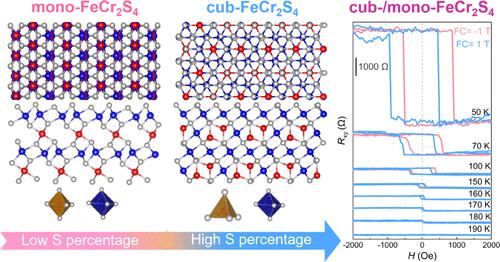常压合成具有强反铁磁性的超薄单斜fer2s4晶体
IF 15.6
1区 化学
Q1 CHEMISTRY, MULTIDISCIPLINARY
引用次数: 0
摘要
二维(2D)材料中非常规相的合成可以揭示在其块状材料中不易观察到的独特性质。最近,在陨石中发现了在极高压力下形成的天然单斜相的FeCr2S4。然而,这种非常规相的性质尚未被探索。在这里,我们设计了一种相选择合成方法,在常压下在缺硫条件下生长2D单斜FeCr2S4晶体,基于我们发现的硫含量依赖的相变。通过将理论计算与输运测量和变温极化拉曼光谱相结合,我们发现由于FeCr2S4固有的非层状结构,FeCr2S4的单斜相是一种反铁磁半导体,其nsamel温度(TN)与厚度无关,为~ 240±10 K(从电阻-温度曲线的拐点确定)。二维单斜FeCr2S4晶体的强大反铁磁性使我们能够使用不同相的FeCr2S4晶体构建铁磁/反铁磁结,在50 K下表现出高达228 Oe的交换偏置场。此外,用二维FeCr2S4制备的磁隧道结(MTJ)在50 K下的存储场窗口为925 Oe,超过了传统的二维层状异质结构。与厚度无关的高tn特性,加上强烈的交换偏置效应,使二维反铁磁单斜FeCr2S4晶体成为未来自旋电子器件中有前途的二维元件。本文章由计算机程序翻译,如有差异,请以英文原文为准。

Atmospheric Pressure Synthesis of Ultrathin Monoclinic FeCr2S4 Crystals with Robust Antiferromagnetism
The synthesis of unconventional phases in two-dimensional (2D) materials can unlock unique properties not readily observed in their bulk counterparts. Recently, the naturally occurring monoclinic phase of FeCr2S4, which forms under extremely high pressure, has been discovered in meteorites. However, the properties of this unconventional phase have not yet been explored. Here, we have designed a phase-selective synthesis approach to grow 2D monoclinic FeCr2S4 crystals at atmospheric pressure under sulfur-deficient conditions, based on the sulfur content-dependent phase transition that we revealed. By combining theoretical calculations with transport measurements and variable-temperature polarized Raman spectroscopy, we revealed that the monoclinic phase of FeCr2S4 is an antiferromagnetic semiconductor with a thickness-independent Néel temperature (TN) of ∼240 ± 10 K (determined from the inflection point in the resistance–temperature curve), due to the nonlayered structure inherent to FeCr2S4. The robust antiferromagnetism in 2D monoclinic FeCr2S4 crystals allowed us to construct ferrimagnetic/antiferromagnetic junctions using FeCr2S4 crystals with different phases, which exhibited an exchange bias field of up to 228 Oe at 50 K. Furthermore, a magnetic tunnel junction (MTJ) fabricated with 2D FeCr2S4 showed a storage field window of 925 Oe at 50 K, surpassing conventional 2D layered heterostructures. The high-TN characteristics that are independent of thickness, coupled with a strong exchange bias effect, position 2D antiferromagnetic monoclinic FeCr2S4 crystals as a promising 2D component for future spintronic devices.
求助全文
通过发布文献求助,成功后即可免费获取论文全文。
去求助
来源期刊
CiteScore
24.40
自引率
6.00%
发文量
2398
审稿时长
1.6 months
期刊介绍:
The flagship journal of the American Chemical Society, known as the Journal of the American Chemical Society (JACS), has been a prestigious publication since its establishment in 1879. It holds a preeminent position in the field of chemistry and related interdisciplinary sciences. JACS is committed to disseminating cutting-edge research papers, covering a wide range of topics, and encompasses approximately 19,000 pages of Articles, Communications, and Perspectives annually. With a weekly publication frequency, JACS plays a vital role in advancing the field of chemistry by providing essential research.

 求助内容:
求助内容: 应助结果提醒方式:
应助结果提醒方式:


